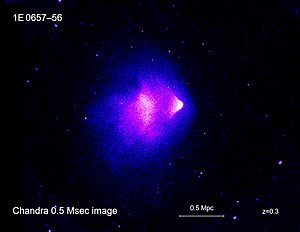Bullet Cluster
| Bullet Cluster | |
|---|---|
 X-ray photo by Chandra X-ray Observatory. Exposure time was 140 hours.
meaning its light has wavelengths stretched by a factor of 1.3. | |
| Observation data (Epoch ) | |
| Constellation(s) | Carina |
| Right ascension | 06h 58m 37.9s |
| Declination | -55º 57' 0" |
| Distance | 4 billion |
| Other designations | |
| 1E 0657-56 | |
The Bullet cluster (1E 0657-56) consists of two colliding clusters of galaxies.[1] Studies of the Bullet cluster, announced in August 2006, provide the best evidence to date for the existence of dark matter.[2] The major components of the cluster pair, stars, gas and the putative dark matter, behave differently during collision, allowing them to be studied separately. The stars of the galaxies, observable in visible light, were not greatly affected by the collision, and most passed right through, gravitationally slowed but not otherwise altered. The hot gas of the two colliding components, seen in X-rays, represents most of the mass of the ordinary (baryonic) matter in the cluster pair. The gases interact electromagnetically, causing both clusters' gases to have their velocity changed more than the stars of the two clusters. The third component, the dark matter, was detected indirectly by its gravitational lensing of background objects. In theories without dark matter, such as Modified Newtonian Dynamics, the lensing would be expected to follow the baryonic matter, i.e. the X-ray gas. However, the lensing is strongest in two separated regions near the visible galaxies. This provides support for the idea that most of the mass in the cluster pair is in the form of collisionless dark matter.
The Bullet cluster is one of the hottest known clusters of galaxies. Observed from Earth, the subcluster passed through the cluster center 150 million years ago creating a "bow-shaped shock wave located near the right side of the cluster" formed as "70 million degree Celsius gas in the sub-cluster plowed through 100 million degree Celsius gas in the main cluster at a speed of about 6 million miles per hour".[3] [4] [5] Strictly speaking, the name Bullet cluster refers to the smaller subcluster, moving away from the larger one.
It provides the best current evidence for the nature of dark matter[6] and provides "evidence against some of the more popular versions of Modified Newtonian Dynamics (MOND)."[7]

"Particularly compelling results were inferred from the Chandra observations of the 'bullet cluster' (1E0657-56; Fig. 2) by Markevitch et al. (2004) and Clowe et al. (2004). Those authors report that the cluster is undergoing a high-velocity [around 4500 km/s] merger, evident from the spatial distribution of the hot, X-ray emitting gas, but this gas lags behind the subcluster galaxies. Furthermore, the dark matter clump, revealed by the weak-lensing map, is coincident with the collisionless galaxies, but lies ahead of the collisional gas. This – and other similar observations – allow good (and interesting) limits on the cross-section of the self-interaction of dark matter."[8]
"[T]he velocity of the bullet subcluster is not exceptionally high for a cluster substructure, and can be accommodated within the currently favoured Lambda-CDM model cosmogony."[9]
Sources and notes
- ^ It is not an open cluster or "cluster of stars" which is also sometimes called a "Galactic cluster".
- ^ Direct constraints on the dark matter self-interaction cross-section from the merging galaxy cluster 1E 0657-56
- ^ Harvard photo and description
- ^ spaceimages.com
- ^ The dynamical status of the cluster of galaxies 1E0657-56
- ^ Dark Matter and the Bullet Cluster by Markevitch
- ^ harvard.edu
- ^ Recent and Future Observations in the X-ray and Gamma-ray Bands
- ^ leidenuniv.nl How Rare is the Bullet Cluster?
Further reading
- arXiv: A direct empirical proof of the existence of dark matter
- arXiv: Strong and weak lensing united III: Measuring the mass distribution of the merging galaxy cluster 1E0657-56 (Marusa Bradac) Fri, 18 Aug 2006 20:06:48 GMT
- arXiv: Can MOND take a bullet? Analytical comparisons of three versions of MOND beyond spherical symmetry
- arXiv: On the Law of Gravity, the Mass of Neutrinos, and the Proof of Dark Matter
- arXiv: The Bullet Cluster 1E0657-558 evidence shows Modified Gravity in the absence of Dark Matter Brownstein and Moffat
- CXO: Bedeviling Devil's Advocate Cosmology (The Chandra Chronicles) August 21, 2006
- CXO: 1E 0657-56: NASA Finds Direct Proof of Dark Matter
- Harvard animation of the collision showing how the dark matter and normal matter become separated.
- Harvard Harvard Symposium - Markevitch PDF 36 color images and text pages proving the existence of Dark Matter from Bullet cluster data
- NASA: NASA Finds Direct Proof of Dark Matter (NASA Press Release 06-297) Aug. 21, 2006
- Scientific American Scientific American article SCIENCE NEWS August 22, 2006 Colliding Clusters Shed Light on Dark Matter that includes a movie of a simulation of the collision
